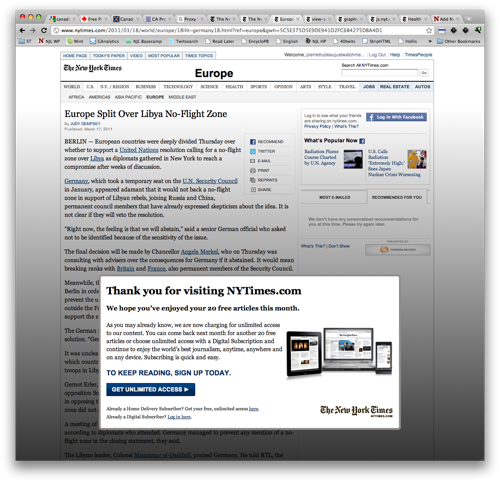Bypass protection on the NY Times website with a three-line script
The development of a system for paid access to content cost the New York Times in the region of $ 40-50 million , according to Bloomberg sources.
It is sad to admit, but protection can be circumvented with the help of three lines in JavaScript.
Now you can read for free on the site only 20 articles per month. After that, the page loads, but a pop-up window immediately appears asking you to pay for access. Subscription prices range from $ 15 to $ 35 per month.

At the same time, you can open the page code - and there will still be the text of the article.
It’s easy to guess that to bypass such a “protection”, it’s enough to simply remove the lines from the page code that cause this pop-up window. Anyone can do this with a Greasemonkey script. Or just install the NYTClean bookmarklet, which has just been published by Canadian programmer David Hayes.
The nyt.js script he wrote consists of only three lines. Moreover, you can access the “paid” article even without any script, if you go to the NY Times website not directly, but from a social network, for example, via a link from Twitter. Columnists NY Times themselves advise readers to do so in order not to splurge on paid access. As you can see, it was not difficult to open the defense. In general, this method of protection, coupled with a very soft restriction of 20 free articles per month, suggests that the NY Times did not set out to strictly protect its content.
Judge for yourself: none of the existing paid content access systems, including those on WSJ, FT or The Economist, provide for downloading articles to the user's browser before asking for payment. And here it happens just like that, and certainly not by chance.
The NY Times understood that it was impossible to completely close free access to articles, so they implemented a system that actually works as “payment at will.” Those who want to continue reading articles for free, and who are too lazy to make extra gestures or feel ashamed, will pay for the subscription. Such "vulnerabilities" are in fact part of the NY Times defense system, in no case to set up a loyal audience against themselves.
Among paid subscribers will be only regular readers of the NY Times - people who go to the site every day and open several articles. Let's see how effective this approach will be.
It is sad to admit, but protection can be circumvented with the help of three lines in JavaScript.
Now you can read for free on the site only 20 articles per month. After that, the page loads, but a pop-up window immediately appears asking you to pay for access. Subscription prices range from $ 15 to $ 35 per month.

At the same time, you can open the page code - and there will still be the text of the article.
It’s easy to guess that to bypass such a “protection”, it’s enough to simply remove the lines from the page code that cause this pop-up window. Anyone can do this with a Greasemonkey script. Or just install the NYTClean bookmarklet, which has just been published by Canadian programmer David Hayes.
The nyt.js script he wrote consists of only three lines. Moreover, you can access the “paid” article even without any script, if you go to the NY Times website not directly, but from a social network, for example, via a link from Twitter. Columnists NY Times themselves advise readers to do so in order not to splurge on paid access. As you can see, it was not difficult to open the defense. In general, this method of protection, coupled with a very soft restriction of 20 free articles per month, suggests that the NY Times did not set out to strictly protect its content.
//Prototype is already installed on NYTimes pages, so I'll use that:
$('overlay').hide();
$('gatewayCreative').hide();
$(document.body).setStyle( { overflow:'scroll' } ); Judge for yourself: none of the existing paid content access systems, including those on WSJ, FT or The Economist, provide for downloading articles to the user's browser before asking for payment. And here it happens just like that, and certainly not by chance.
The NY Times understood that it was impossible to completely close free access to articles, so they implemented a system that actually works as “payment at will.” Those who want to continue reading articles for free, and who are too lazy to make extra gestures or feel ashamed, will pay for the subscription. Such "vulnerabilities" are in fact part of the NY Times defense system, in no case to set up a loyal audience against themselves.
Among paid subscribers will be only regular readers of the NY Times - people who go to the site every day and open several articles. Let's see how effective this approach will be.
